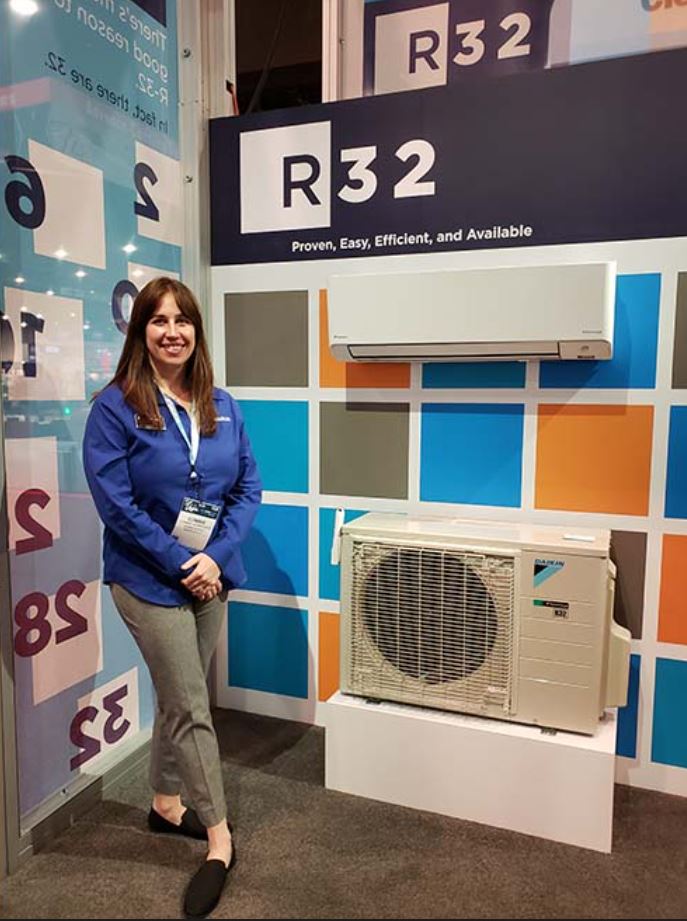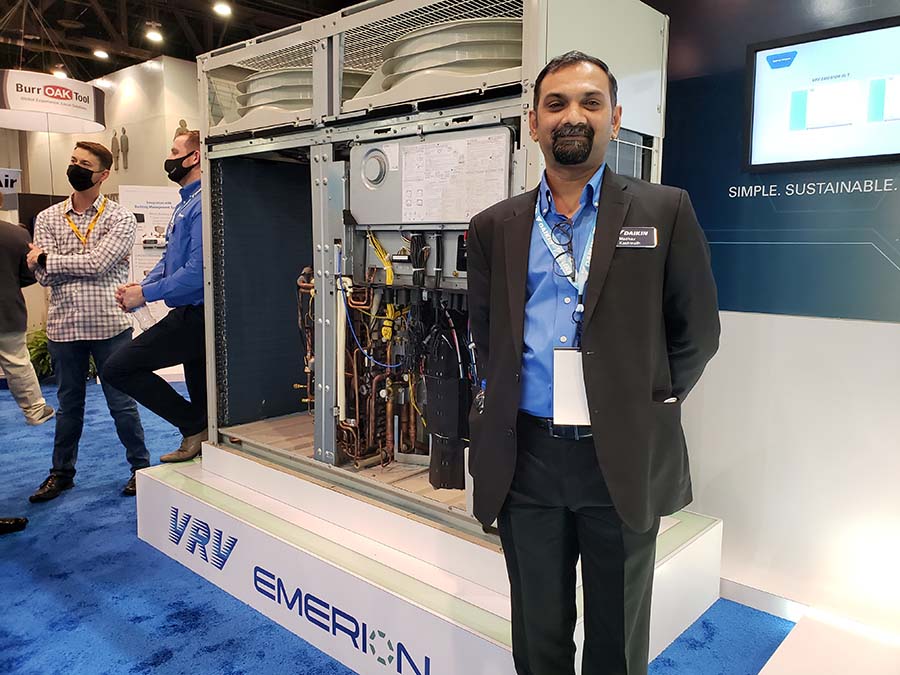One of the highlights at the Daikin North America booth was its new R-32 ductless mini-split system, the Daikin ATMOSPHERA. The new system offered Daikin the opportunity to not only highlight its leadership in the transition to lower-GWP refrigerants, but to also highlight the product’s significant technology achievements.
“As the largest HVAC manufacturer worldwide, we feel the responsibility to deeply think how we can benefit consumers and the environment by leading technological advancements,” said Marc Bellanger, director of marketing and communications at Daikin North America LLC. “The AHR Expo provides the perfect stage to showcase all of our efforts and successes while providing the opportunity to demonstrate how we’re different.”
New and Exciting

SIZE RANGE: Connie Schroder, senior product manager, stands in front of the new R-32 system, Daikin ATMOSPHERA, which is available in four sizes ranging from 9,000 to 24,000 Btuh. (Staff photo)
As noted above, one way in which Daikin is differentiating itself is through the introduction of Daikin ATMOSPHERA, the next-generation single-zone ductless product line that utilizes the low-GWP A2L refrigerant R-32. Daikin ATMOSPHERA is available in four sizes from 9,000 to 24,000 Btuh and is the first product from Daikin to use R-32 refrigerant in North America. The new product reduces the GWP impact on the environment by up to 80% compared to similar R-410A systems.
“We were really excited to have R-32,” said Connie Schroder, senior product manager at Daikin North America. “It lets us pull some different levers for performance, so we took our premium flagship R-410A model and boosted up its SEER. Then we took our cold climate model and boosted up its low ambient heating capacity as well to have this one system that can cover all climates.”
R-32 has been shown in Daikin’s labs to increase efficiency by up to 12% over R-410A with comparable products, lowering electricity consumption and indirect emissions. A noteworthy feature includes a new hybrid cooling technology that dehumidifies even in low cooling loads and continues to maintain dehumidification once a set point temperature is reached, said Schroder. The indoor unit also includes built-in Wi-Fi for connectivity to the Daikin Comfort Control App and is compatible with several other Daikin controllers, including the Daikin One+ smart thermostat.

NEW IMPROVEMENTS: The completely reengineered VRV EMERION offers new improvements in design, performance, installation, maintenance, and connectivity. (Courtesy of Daikin)
Also featured at the booth was the newly engineered VRV EMERION. The latest offering incorporates several of the top features from the existing VRV IV X and VRV AURORA, as well as new improvements in design, performance, installation, maintenance, connectivity, and sustainability compared to previous models. Some of these key features include up to 30% improvement in IEER part-load cooling efficiencies compared to previous series; design flexibility to enlarge system from single to a dual module without changes to installed main pipe sizes; new three-segment panel design for ease of service and maintenance; and continuous heating for dual modules and also available for single modules in 16 to 20 tons.

NEW VRV: Madhav Kashinath, director of VRV products, stands alongside the VRV EMERION system, which bears the tagline of simple, sustainable, and connected. (Staff photo)
“From a simplicity standpoint, VRV EMERION is simple for the contractor to install, and it is simple for the engineer to design,” said Madhav Kashinath, director of VRV products at Daikin North America. “It has the industry's longest piping limitations with a vertical separation of up to 361 feet. Historically, the industry has only had 295 feet. In realistic terms, this means with the VRV EMERION, you can provide a 70-story building with a VRV solution. That is something that makes it completely unique.”
Another focus at the booth was Daikin One Cloud Services, which provides Daikin Comfort Pro (DCP) contractors the opportunity to grow their business and connect with their customers. This cloud-based tool, which requires a Daikin One+ smart thermostat, allows DCPs to configure, monitor, diagnose, and adjust the performance of Daikin systems remotely, potentially eliminating the need to send a truck and technician to a home.
“DCPs can visualize the data and engage with their customers on comfort issues and then take action,” said Bellanger. “DCPs who have been given permission by the customer can remotely monitor system data ranging from temperatures, humidity, and IAQ to heating and cooling demand, plus critical and minor errors. Technicians can access not only current live data but also history back to the day the system was cloud-connected.”
Current Trends
In talking about current trends, Bellanger noted that the HVAC industry and Daikin continue to contend with the ongoing supply chain issues. However, he noted that with Daikin products, including its VRV and ductless systems, the company manufactures its own products and is also its own supplier of many required components, including electronics, compressors, and even refrigerant.
On the residential side, Bellanger noted that smart home technology continues to develop much more informed HVAC consumers who have historically depended primarily on contractor recommendations for their purchases.
“Consumers are now playing a much larger role in the informed decision-making process when purchasing new or replacing their HVAC equipment,” he said. “Additionally, the COVID pandemic has forced many people to work from home, where they have recognized deficiencies with their heating and cooling systems along with a much higher awareness of IAQ issues and opportunities to upgrade their existing systems.”
On the commercial side, VRV/VRF technology and applications continue a path of exponential growth, he said.
“Unlike many other manufacturers, at Daikin, we engineer and manufacture our own systems, which allows us to engineer our VRV products specifically for the North American market. One key example of this is Daikin’s ability to connect our VRV products to commonly used residential-style gas furnaces. Rather than trying to change the commercial market, Daikin is adapting higher levels of VRV technology to the existing North American applications.”
In the commercial rooftop market, this past year Daikin filled out a complete line of both standard efficiency and high efficiency rooftops that also include several factory-installed options, such as hinged access panels and hot gas reheat.
“The new standard and high efficiency rooftop products are a great addition that complements the Daikin Rebel rooftop product line offered by our Daikin Applied division,” said Bellanger.



Report Abusive Comment